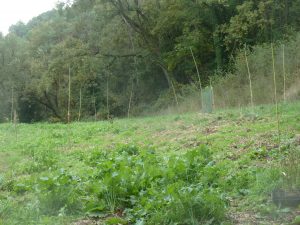The main project we are working on is to create many Food Forest on the land.
A Food Forest is a system of production that combines different layers of plants (big trees, small trees, shrubs, herbaceous, ground cover, underground crop, climbers, etc) in a same space.
The idea is to mimic a forest ecosystem to reduce as much as possible the maintenance needed in the land (watering, weeding, etc). A forest doesn’t need humans to grow, so what would happen if we copy a forest ecosystem but that we replace every plants by some plants that are useful to humans consumption ? By useful, we understand mainly for food security, but as well for medicinal, construction, crafts, etc purposes. As well, if we multiply the layers of production vertically (from ground cover plants to big trees) in a same space, won’t this space become a much more productive space than a space cultivated on only one layer ?
One of the main key is biodiversity. The more diverse an ecosystem is, the more it will keep resilient to pests, diseases, etc. No need of crasy inputs of pesticides or fungicides if the system can maintain itself !
The idea is as well to devellop a layer of useful/edible plants that will cover the soil and avoid too many wild plants to grow around ; then we have less need of weeding.
We want to use as much as possible perennials plants (plants that will not die after one or two years, like annual or biennial plants). This limits the need of being present to work on the land (no need to sow or weed each year).
We want to let wild plants grow freely in our forest garden. It is pretty amazing to see how nearly all these wild plants have uses for humans, especially nutritionally and medicinally wise. And these wild plants don’t necessitate maintenance ; they are self sufficient !
The fertility is mainly ensured by the use of Nitrogen Fixer plants (that fixe the Nitrogen from the air and later on give it back to the soil) and bio-accumulator plants (that have big tap roots that can take nutrients from deep down in the soil, and later on give it back to the surface). As well, our no-dig system allows the soil life (mainly bacterias) to make the organic matter available to the plants. The proximity we have with the forest and the fact that we don’t dig gives us a very “intelligent” soil due to his high presence of beneficial fungis (mycorrhizal fungi) that help the plants to find nutriments and share them between themselves. These fungis also reduce the need of watering of a plant, as well as its need of light ; they also make plants more resilient to pests and diseases.

A view of the beginning of our forest garden : each planted trees are marked with a cane stick. The green manure and ground cover here is a mix of Vetch, Cabbage, Mustard, Clover, Alfalfa, etc
ARTICLE : The main plants we use in our forest garden
ARTICLE : The plant propagation techniques we use
Articles to come :
- Key points that we used to design our forest garden (light and space consideration, etc)
- Soil preparation techniques (greeen manure, etc)
